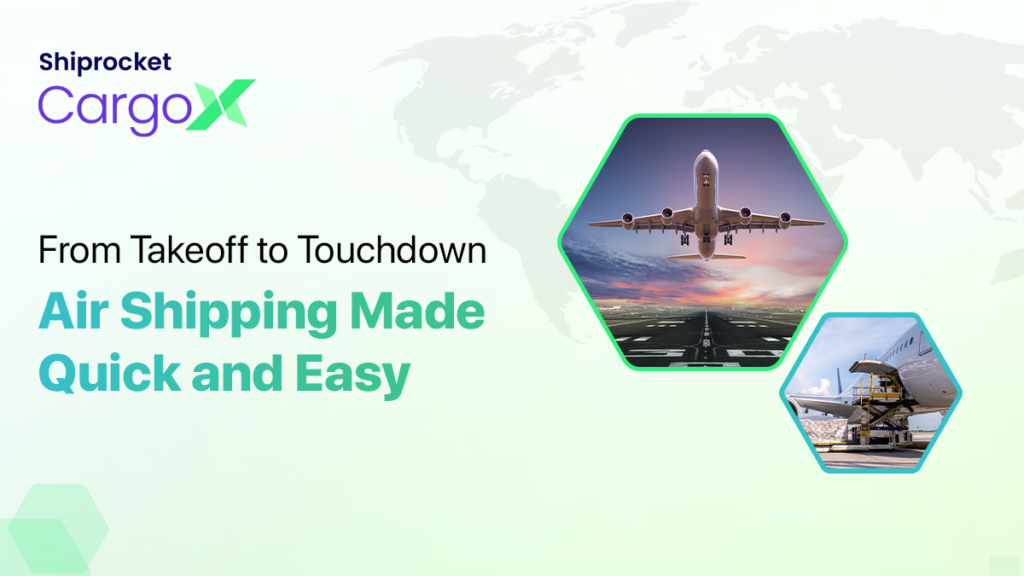Airport to Airport Shipping: Everything You Need to Know
The world has come a whole lot closer with air transportation. It has also facilitated the growth of international trade. Ever wondered how air shipping works? Do the shipments reach the consumer’s doorstep? The air cargo industry uses different methods for air freight shipping. Airport-to-airport shipping moves your consignment to the destination airport. From there, the shipper will be required to make arrangements for the last-mile delivery.
This article tells you all there is to know about airport-to-airport shipping, the comparisons with other shipping methods, the factors affecting its price, and more.

What is Airport to Airport Shipping?
Once a consignor has made arrangements for the delivery of items to a consignee using the air cargo shipping services, the necessary paperwork must be completed to proceed smoothly. The items will be packaged according to the requirements of the courier that the consignor has selected. The courier will pick up the parcels from the consignor’s place and ship them to the air cargo terminal. The items will be subjected to customs checks to make sure that the goods are safe for transport and all the paperwork will be double verified. As soon as the goods are cleared for shipping, the items will be placed on a pallet and loaded onto an airplane.
As the air carrier reaches its destination, cargo will be unloaded and the next phase of security check and paperwork verification will be done. The carrier starts processing the goods through its chain of delivery to ensure that the items reach their destination properly.
Comparison with Sea Shipping
The table below highlights the key differences between airport-to-airport shipping and sea shipping.
| Criteria | Airport-to-airport shipping | Sea shipping |
|---|---|---|
| Urgency of Delivery | Airport-to-airport shipping is best suited for time-sensitive deliveries and shipping products that have a short shelf life | Suitable for goods that have long lead times and speed of shipping is not a major concern |
| Budget Constraints | Larger shipping costs and cost savings on inventory and storage due to more efficient transit times. | Lower shipping costs and more budget-friendly for non-urgent shipments |
| Type of Cargo | Most suited for fragile, high-value, perishable, and urgent deliverables | Most suited for bulk cargo, machines, vehicles, and less time-sensitive goods |
| Accessibility and Destination | Suited for all locations that have airports | Not suitable for land-locked countries |
| Environmental Concerns | Has a greater carbon footprint and is not suited to align with sustainability goals | Environmentally friendlier than other shipping methods |
Importance of GPS and Tracking in Airport-to-Airport Shipping
Tracking and the rise of GPS technology have made monitoring orders a whole lot easier in the logistics industry. It is more than just identifying where your vehicle is. It gives additional advantages like the ability to track the valuables within a carrier while in transit. Moreover, temperature-sensitive shipments like pharmaceuticals and perishables need accurate conditions for storage, freight management systems, and transportation.
GPS technology also offers a solution for this issue as delicate items can be monitored throughout the transit period to ensure that they are stored at the right temperatures until they reach their destination. It minimises the chances of damage, spoilage, and loss that can result in financial ruin.
Factors Affecting Rates of Airport-to-Airport Shipping
The following variables may affect the cost of airport-to-airport shipping:
- Delivery speed: Due to the rise in eCommerce businesses, there is a greater demand for overnight deliveries, which significantly impacts the cost of shipping. The cost will vary depending on the shipping service option chosen. Requirements for faster delivery are typically more expensive.
- Shipment weight and volume: Since weight and volume are the primary factors that dictate how much room a shipment will take up on an airplane, the cost will become higher as the parcel’s size increases. Therefore, controlling your expenditure requires refining your packaging strategies.
- Distance: There is a cost associated with transporting a shipment from one airport to another. These include expenses for labor, fuel, upkeep, and other things. The route and location are also important. Naturally, if the place gets farther away and more inaccessible, the costs will also go up.
- Environmental considerations: The cost of transporting a package is significantly influenced by environmental factors. Due to the increased risk concerns, the cost of transportation will increase during wet and dangerous weather. The need for aviation fuel will also be taken into consideration.
- Disruptions: These can be brought on by traffic jams, a shortage of fuel, an increase in labour expenses, the inability to find carriers owing to high demand, etc. Airport closures and other unanticipated events can also hinder freight forwarding and increase costs.
Transit Times and Delivery Estimates in Airport-to-Airport Shipping
Transit time is the time interval from the moment of loading cargo onto the carrier until it unloads at the airport of the destination. It is denoted in hours or days. It is a crucial timeline any freight forwarding business, airport authority, and shipper needs to understand. The participants in the logistics process should have the estimated transit time of cargo delivery for precise planning and preparation of airport services, customer procedures, unloading processes, handling of shipments, and more.
Transit time and delivery rates can be estimated using several online calculators. They determine these times using several factors like distance, air traffic, clearance times, and more. These might not be extremely precise, but they do provide you with a rough figure to plan your processes.
Conclusion
Airport-to-airport shipping is extremely popular these days with the rise in e-commerce businesses. Understanding how it functions and checking to see if airport-to-airport shipping lies within your budget can help you make your shipping processes more efficient. Airport-to-airport shipping takes a lower transit time when compared to other modes of shipping. It is extremely beneficial when you have time-sensitive and perishable shipments. Although it has a larger carbon footprint, it has several advantages that make it such an appealing shipping method.
Shiprocket CargoX offers a great solution that simplifies international air cargo shipping. It aims to make the process more efficient for businesses. It helps you streamline the complexities of cross-border shipping with a range of extensive features. These include pickup within 24 hours, complete visibility into the shipment process, easy documentation, quick invoicing, and more. CargoX is also committed to reliability and transparency with no hidden charges and restrictions on shipment weight. Moreover, it boasts an extensive global network coverage of more than 100 countries. What’s more? With CargoX, you get customised shipping plans to your business requirements, in addition to compliance for high service level agreements.
Airport-to-airport shipping has many benefits, with speed, security, and reliability being the most significant ones. Other benefits include lower logistics costs, less heavy packaging required, reduced need for local warehousing, lower inventory holding costs, and lower insurance premiums.
Fuel costs, handling fees, and other charges can still result in higher air shipment costs. Sending shipments via air is also prone to delays due to weather conditions, geopolitical situations, etc. Lastly, air freight has a low carrying capacity and requires specialized handling and packaging.
Airport-to-airport shipping is ideal for sending time-sensitive and lightweight shipments. Some goods you can ship by air include high-value items, fashion and luxury goods, medicine supplies, pharmaceutical products, perishable goods, products that need to be shipped in temperature-controlled conditions, and more.
You should keep some points in mind when sending shipments via air. Decide an air transportation option that fits your budget, timeline, and needs. Prepare your documents, pack your shipments, calculate your shipment’s weight, prepare for customs and ship. One bonus tip: don’t overpack your goods.




